Amir Hariri was born in Tehran, Iran, and immigrated to the United States to attend college in the early 1990s. His artwork incorporates his professional background in design and engineering, as well as studies in anatomy. Amir has exhibited nationally and internationally, with pieces included in public and private collections in the United States, Italy, Spain, Hong Kong, and Japan. Recent awards include an Artist Fellowship in Drawing from the New York Foundation for the Arts. He earned a Masters’ degree in engineering from Cornell University and a Bachelors’ degree in Architectural Engineering from the University of California, San Diego. His work appears in The Woven Tale Press Vol. VIII #3.
Interview with Amir Hariri
By Jennifer Nelson, WTP Feature Writer
Nelson: What led you to leave a career in design and engineering to become a full-time artist, and what were the challenges of switching professions?
Hariri: When studying physics and mathematics in college, I was drawn more to the beauty of the formulas than their actual utility as a solution to a specific problem, per se. Ultimately, it’s not that a building or structure has a preordained purpose, whether providing shelter or a bridge that spans a ravine, for example, but, it’s the forms that construct the components, the detailing of a building which is in dialogue with the forces it is trying to resist, that inspire a delicate negotiation.
During my design career, I found myself drawn, more and more, to conceptual ideas such as the role of collapse and catastrophe, which tended to be avoided or mitigated as a practical matter. Therefore, I gravitated towards a visceral discourse, traditionally the realm of the artist, and more relevant to my point of view. I was also inspired by the work of artists such as Calder and Matta, who studied engineering and architecture and keenly incorporated certain of these skill sets into their creations.
The most difficult part of my transition has been the lack of a robust professional network that comes with having been part of an academic institution. I have worked to bridge this gap through my participation in various residencies and by choosing studio environments that are conducive to critical dialogue.
-
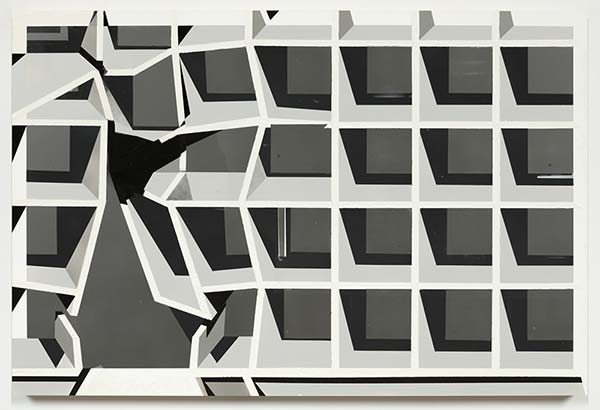
Amir Hariri, Ruptured. Oil and acrylic on board, 30” x 24”
Nelson: How did growing up in Iran, where you witnessed revolution and war, impact your artwork and its messages?
Hariri: The weight of fear and isolation brought on by the revolution and the war, further enhanced by witnessing executions and bombings, allowed me to focus my attention on how we are forced to adapt and survive. It also allowed me to form an invisible bond with other survivors as I was able to relate my encounters to images from World War II, for example, or more recently, to what’s happening in Syria. This visual record keeping through association has enabled me to draw parallels between building deconstruction and the despair, yet resiliency, of the exiled inhabitants. These moments, which span fluidly from demolition to renovation, form the foundation of my imagined dwellings. My goal is to help awaken a new appreciation for forgotten spaces.
-
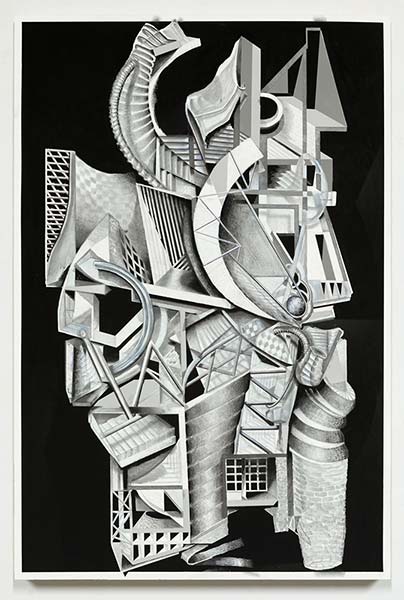
Amir Hariri, Bull Column. Oil and acrylic on board, 24” x 36”
Nelson: Please talk about your process in creating such paintings as “Bull Column,” with its meticulous detail and geometric shapes, and your use of acrylics and oils in black and white.
Hariri: I have always been fascinated by critical observations made by visual artists, with special attention given to works of modernist abstraction, and its concerns with the act of painting, in itself, not only generation, but internal and constant discrimination.
Many artists from the early Renaissance (Piero, Uccello), through Delacroix and the proto-modernism of Cezanne, to the mid-century critical thought (Graham, Gorky, Guston) have eluded to an analytic framework that connects this act of picture making to an invisible but discernible overarching method. I am continually in search of identifying and refining this method through the deconstruction and then the rebuilding of the image.
Here, “Bull Column,” which references the columns of the ancient Achaemenid capital of Persepolis, is conceived in this way by breaking down the idea of the column ruin, both shape and context, through a historical lens.
I tend to prefer monochromatic painting when I focus on certain tactile aspects such as construction materials (concrete, metal) or context; here the memory of black and white historical photos I had seen from the original documentation of the site (University of Chicago archives). But it also refers back to my printmaking days working in stone lithography. I find that the textural richness, achieved by the domination of contrast, enhance the drama and mystery and relate, more closely, to the romanticized ruin.
In addition to painting in oil, I tend to also use spray and house paint (acrylic) in combination with sand, plaster, cement and, sometimes, wood. Again, the goal is to inspire a haptic response similar to an encounter with a construction site.
-
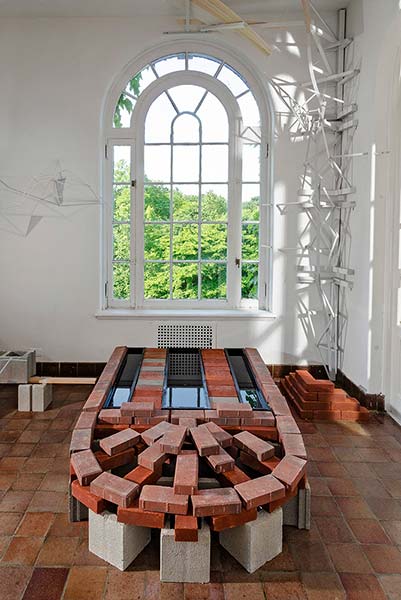
Amir Hariri, Fracturing Half Moon. Sunroom installation at Wave Hill.
Courtesy of the artist and Wave Hill. Photo: Stefan Hagen
Nelson: Your work varies from the gigantic to the tiny and involves different mediums such as sculpture, painting, and printmaking. How do you decide the scale of a project, as well as the media you will use?
Hariri: To be honest, most issues with scale relate directly to the size of my studio, which is quite small (about two hundred square feet). I have, therefore, become quite good at building my sculptures to scale (there are usually 1-12 scale) and also to build modular sections that can be assembled in-situ to scale. My main goal is to respond to each space as directly as possible, which also drives the scale. As an example, my recent show at Wave Hill was driven by the size of the sunroom and the placement of the windows.
As for working in various mediums, it stems from my process working from memory and impression. I tend to utilize drawing, painting, and sculpture, simultaneously, and in an iterative fashion to make sure and capture visceral moments as they present themselves. These exercises are then either distilled to a single medium or presented as an assemblage depending and how closely they capture the desired experience.
-
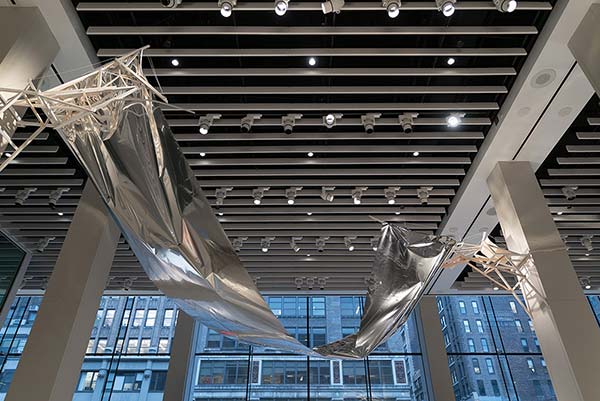
Amir Hariri, Non-Empty Many-Fold. FIT lobby installation, wood, fasteners, Mylar
Nelson: How did you conceive of the idea of “Non-Empty Many-Fold,” an installation at the Fashion Institute of Technology that features a silver banner draped between columns, and what materials and techniques did you use in creating this work?
Hariri: My plan was to respond to the brutalist architecture of the lobby within the context of its recent renovation, its location as part of the FIT campus and within the broader street and cityscape. The goal was to understand an environment from the perspective of the space itself, through interactions and reflection as visitors, passersby, students, and their work are experienced. I am really interested in what happens when the idea of purpose is exhausted and the abandoned building reflects on its past. I was also inspired by the art of fashion design practiced within the grounds especially as it relates to form and structure: how fabric comprehends and compliments the human anatomy, again, transcending utility.
Technically, having a large installation safely suspended between the columns at an overhead height of about twenty to thirty feet required a lightweight structure that could be attached through non-invasive means. I, therefore, used lightweight bass and balsa wood and designed the system to work with the Mylar draping, as a whole, distributing the weight through the coupling of tension and compression. I utilize my engineering training in as many projects as I can since it helps unify the pieces with their surroundings.
-
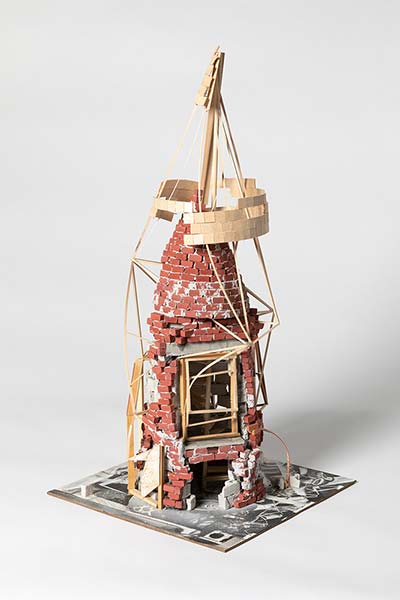
Amir Hariri, I See Again in Memory. Cement, clay, plaster, wood, 12” x 12” x 26”
Nelson: What are the sources of inspiration for your artwork?
Hariri: My focus has been on the study of urban areas in transition. I have addressed issues related to displacement and redevelopment in areas such as the Domino Sugar Factory in Brooklyn, Hudson Yards, and the High Line, and the broader Bronx. I have developed an approach to capture what I refer to as “subconscious interactions” with our environment. By relying on the opacity and fragmentation of memory and distancing myself from certain interactions, I have been able to reconfigure certain dormant experiences in the studio that are not mimetic or referential. But they do still evoke certain qualities of occupied and experienced space.
It all started when the demolition and redevelopment of the Domino Sugar Factory was being debated in Brooklyn. I realized that we sometimes only appreciated certain buildings or environments once they were being changed or removed. I am intrigued by these memories of abandoned places and how their deconstruction and reconstruction can form an impression or historic narrative.
We react to decay, either by resisting or succumbing to it. A metaphoric linkage between buildings and our human condition: they are born, serve a purpose, then die, are removed, turn to ruin, or preserved in some romantic way.
-
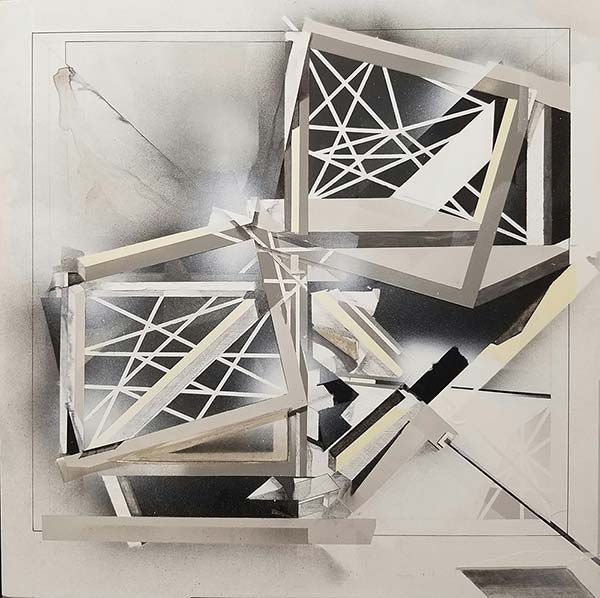
Amir Hariri, Elegraph™ Base Plate II. Oil, acrylic, cement, plaster on aluminum plate, 16” x 16”
Nelson: What are the advantages of using the Elegraph printmaking platform in such work as “Base Plate II,” and how does this technology work?
Hariri: At first, it was quite difficult for me to fully grasp the artistic potential of the Elegraph process, even though I generally understood the technical side of scanning and printing in layers. But what I had not seen in other technologies being employed by artists, such as 3D printing, was the relationship between the artist and a master printer or technician, which reminded me of traditional printmaking. I realized that there was a direct correlation between proofing that could also become interesting given the flexibility of this medium. I immediately leaned towards the idea of combining various materials and steps to achieve something that I could not imagine as a complete piece, because it would hinge on a temporal combining and removing of various elements in each step. It is this flexibility afforded by the use of point-cloud technology that fits so well with my own process of making and un-making.
I created my images on two aluminum base plates using pen, pencil, acrylic, plaster, and cement. These plates were then digitized and manipulated using software to introduce elevation/depth and combined to produce the final series of three Elegraphs digitally printed on aluminum. As part of the proofing process, I utilized both a physical relief proof with computer techniques to conduct various shadow studies, not possible in traditional printmaking, that utilize relief. Furthermore, the endless ability of combining plates, parts of plates and removing others is something quite unique to this process.
-
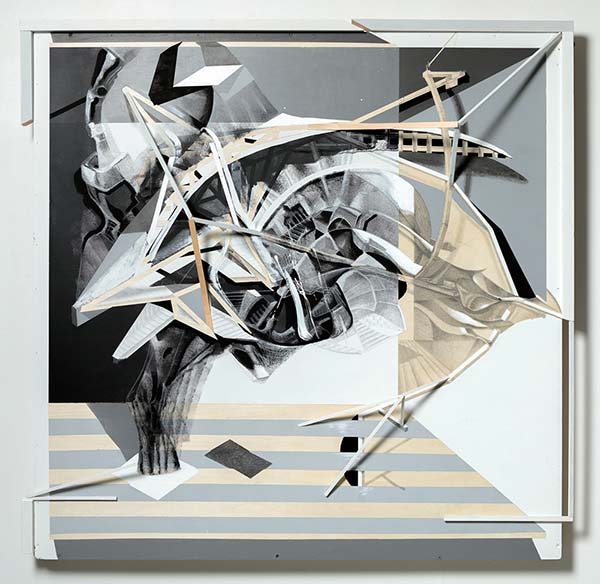
Amir Hariri, Cobweb Afternoon. Graphite and acrylic on panel with wood assemblage, 49” x 50” x 6”
Nelson: How do you see your artwork evolving in the future?
Hariri: I have been influenced by the disruptive response to academic or socio-political norms such as Dada or the Bauhaus. I am especially keen on the changes that occur after major upheavals such as major conflicts or natural disasters and, although I have been mostly focused on urbanism in duress, I can see my work shifting to consider effects from the most recent pandemic. There is a rich history of how architecture has evolved after periods of contagion and it would be really interesting to see how New York City will adapt and how this period of transition is experienced by the city’s different communities and neighborhoods.
In addition, the work of artists such as Matta-Clark, Smithson and, more recently, Leandro Erlich have given me confidence to propose larger scale projects that engage the viewer in a more direct and reactionary way.
Copyright 2020 Woven Tale Press LLC. All Rights Reserved.
